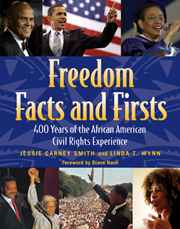
Thurgood Marshall (1908-1993)
U.S. Supreme Court Justice
Thurgood Marshall's long and illustrious career was capped by his 1967 nomination to the highest court in the land--the United States Supreme Court--where he became the first African American to hold the coveted position of Supreme Court Justice. At fifty-nine, the son of a sleeping-car porter and the great-grandson of a slave became a sign of progress for many. He was viewed with the utmost respect for all of his years on the bench, retiring June 27, 1991. Marshall died at the age of eighty-four in 1993. He was laid in state in the Great Hall of the Supreme Court of the United States on the same bier where Abraham Lincoln once rested. Over 20,000 mourners paid their last respects to Justice Marshall.
Born in Baltimore, Maryland on July 2, 1908, Marshall earned a B.A. from Lincoln University, hoping to become a dentist. He changed his mind, however, and instead went to Howard University's law school, graduating in 1933 at the top of his class. He immediately went into private practice in Baltimore, where he remained for five years.
In 1936, he entered into what was going to be a long and illustrious career with the NAACP, starting as an assistant special counsel. In 1938, as a national special counsel, he handled all cases involving the constitutional rights of African Americans. Then, in 1950, he was named director-counsel of the organization's eleven-year-old Legal Defense and Education Fund, a position he held until 1961. In 1954, as part of an imposing team of lawyers, he played a key role in the now-historic Supreme Court decision on school desegregation, Brown v. Board of Education, which overruled the "separate but equal" doctrine in public education. He also figured prominently in such important cases as Sweatt v. Painter (requiring the admission of a qualified black student to the law school of Texas University) and Smith v. Allwright (establishing the right of Texas blacks to vote in Democratic primaries). Of the thirty-two cases that he argued before the Supreme Court, Marshall won twenty-nine.
Marshall was also known for his lifelong support of rights for women. Constance Baker Motley commented that Marshall hired her for an NAACP counsel position when virtually every other employer had turned her down. He also encouraged her when she argued cases before the Supreme Court, and made certain he pointed out other African American women role models.
In 1961 Marshall became a federal circuit judge for the second circuit. In 1946 he was awarded the prestigious Spingarn Medal for his many achievements. He had over twenty honorary degrees to his credit. Marshall was the first recipient of the American Bar Association's Thurgood Marshall Award in 1992. The award recognizes those who fought for personal liberty and civil rights. Because of declining health, Marshall resigned from the court in 1991 and died on January 24, 1993.
From African American Almanac: 400 Years of Triumph, Courage and Excellence by Lean'tin Bracks, (c) 2012 Visible Ink Press(R). A wealth of milestones, inspiration, and challenges met . . .
 |
African American Almanac: 400 Years of Triumph, Courage and Excellence
by Lean'tin Bracks, PhD
A wealth of milestones, inspiration, and challenges met. . .
The most complete and affordable single-volume reference of African...
Read More »
|
ISBN: 9781578593231
$29.95
|
 |
Freedom Facts and Firsts: 400 Years of the African American Civil Rights Experience
by Jessie Carney Smith, Ph.D. and Linda T Wynn
Spanning nearly 400 years from the early abolitionists to the present, this guide book profiles more than 400 people, places, and events that have...
Read More »
|
ISBN: 9781578591923
$44.95
|
 |
Black Firsts: 4,000 Ground-Breaking and Pioneering Events, 2nd Edition
by Jessie Carney Smith, Ph.D.
Black Firsts is a testament to a rich but often overlooked part of our history. Jessie Carney Smith, William and Camille Cosby Professor of the...
Read More »
|
ISBN: 9781578591428
$24.95
|
 |
Black Heroes
by Jessie Carney Smith, Ph.D.
"If there is no struggle, there is no progress," wrote Frederick Douglass. "This struggle may be a moral one; or it may be a physical one; or it may...
Read More »
|
ISBN: 9781578591367
$69.95
|









